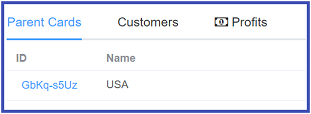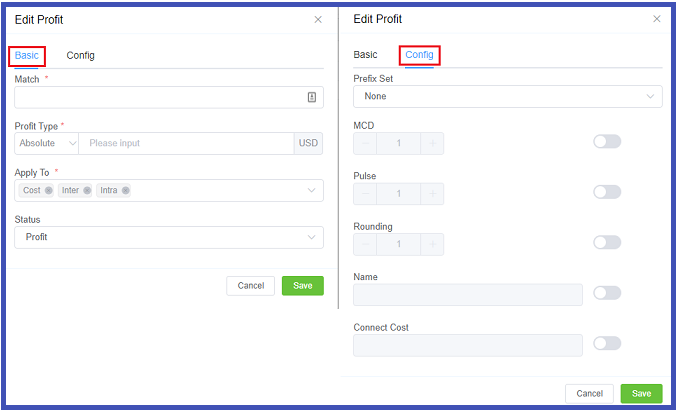Customer Rate Card¶
Management Customer Rate Cards
Customer Rate Cards let you manage the rates for customers, edit customer profiles, and view important information.
Before configuring, we suggest you review Rate Card Overview then Rate Card Setup in the ConnexCS Video Guide.
You will also want to have at least one Provider Rate Card configured.
Customer Rate Card Functions¶
-
Bulk Build: Select multiple cards to perform the build. This is usually done after you've set up your properties and profit, or when you need to gather multiple customers after a rate change.
-
Bulk Edit: Edit multiple cards at a time for some Properties settings.
-
Delete: Delete a customer rate card by selecting its name from the list and then clicking the trash bin icon.
Overview¶
-
Name: Click the name of the provider to see an individual rate card and management options. If a Rate Card name shows a yellow warning or red alert, these will show details about the card. It may be stale or have some sort of error.
-
Direction: Cards are either Termination (calling out to PSTN) or Origination (DID numbers receiving calls from the PSTN). Termination is the most common card used by ConnexCS customers.
-
Currency: The currency for the provider's region (typically USD, EUR, or GBP).
-
?: Lists the upstream providers (parent cards) as well as the total number of customers associated with the card (as specified in Customer: material-menu-right: routing). Any changes made to this card will impact the customers associated with the card.
Click on the Provider ID or Customer Name to view the configuration.
-
ID: A system identifier that acts as a placeholder and prevents confusion between similarly named items.
-
Rule Count: The number of rows in the Rate Card.
-
Compile: Displays which Customer Rate Cards are in sync with the Provider Rate Cards.
 Stale (needs compilation)
Stale (needs compilation)
 In sync
In sync
Reasons a card marked as Stale
You can refer to a Rate Card as Stale when the information presented isn't the same as the live / active revision.
Some common examples of this are when the customer generates Customer cards from Carrier cards (preferred method) OR when they revise a carrier card.
In both cases, cards are marked as Stale and require compilation.
Compile Example
Provider updates their rates and the customer uploads the new Provider Rate Card into ConnexCS, which increments the revision.
All associated customer cards will be out of sync (orange pause icon). To correct this, select all stale cards, then click Bulk Build to update the new rates and routes.
Create a Customer Rate Card¶
Once created, there are several options to complete the card.
- Click .
- Complete the required fields. (For details, see Configure Customer Rate Card below.)
- Click
Save. - In the new card, select Profits and then click . (For details, see Profits under Functions below).
Option 1: Build from Provider Card This is the preferred method and requires you to select a Provider Rate Card in Properties > Basic.
Click Build and confirm.
A notification will tell you if the build was successful. You may need to refresh the card to see the new settings.
Option 2: Manual Add
To manually add Rate Card rows, select Create Draft and then add / modify / delete required rows from the browser.
Option 2: Bulk Upload The final method for configuring a Customer Rate Card is to import/upload it:
- Click Bulk Upload > Upload.
- Select the file and click
Open. - Right-click the first row of data (not headers) and select
Set Start Row. - Right-click and map the columns. It's important to map all fields based on the Rate Card columns. For example:
- Col 1 - Prefix
- Col 2 - Name
- Col 3 - Cost
- Select Upload to Sever and confirm.
- Select Yes to make this active immediately.
- Once complete, the new card will display the Provider rules and the Profit rules.
Configure the Customer Rate Card¶
Main tab¶
Email: This feature allows providers to email rate cards to customers as an attachment.
It's a convenient way to send customers official information relevant to their accounts.
Click Email, enter the email address and click Send.
Audit Log: Review any changes made to the card settings.
Functions:

- Revision: List all versions of changes on the card.
- Create Draft: Create a blank revision to manually add all prefixes and rows. This will only contain rows added manually and doesn't retain any previous revisions.
- Edit Revision: Make inline edits to the current revision. Upon
Save, you can select to make this new revision Active. This keeps the previous revision and the changes made. - Delete Revision: Select a revision to delete.
-
Download: Download a CSV file of the Rate Card.

-
Parent Cards are the Provider Rate Cards associated to this card.
- Customers lists the specific Customers using this card.
-
Profits lets you configure profit rules. This is most useful on cards with a high number of rules.

Click each tab for configuration details
- Match: Enter the prefix to match, either as a Regular Expression or a standard prefix (numeric only, typically an international country code, not a provider or customer tech prefix). Adding an up arrow
^on the prefix draws all associated prefixes from the provider card. For example, if you enter '49, it will include '491', '492', '4912345', and so on. -
Profit Type: Select how to add profit:
Absolute- actual value chargedRelative- amount entered is added to the cost from the carrierPercent- cost from the carrier multiplied by this percent -
Apply To: Setup rules to govern how Profit is applied to different types of calls.
- Status: Use Blocked, here or after importing a Carrier Rate Card, to disable specific prefixes.
- Prefix Set: Select Prefix Sets (check here to simplify the Profit configuration).
- When you disable MCD (Minimum Call Duration), Pulse, or Rounding, that setting will select the worst case scenario as defined by the carrier.
- Name: You may choose to add a name to identify the Profit rule
- Connect Cost: one-time fee for connecting the call.
Profit Type
Using Absolute and Relative can be useful, specially when dealing with large cards and your providers prices change; with a single click you can regenerate the customer rate cards.
Revisions tab¶
The Revision tab displays up to 8 most recent changes made to a rate card. The two most recent revisions are available as Active or Inactive, the rest will be in Archive state.
To change Revision status:
- Click
Archivenext to the Revision to send it to the Archive. This may take some minutes. - To make that version Active, click
Inactive. This may take some minutes. - Use the Date Live function by the Revision to set a future date to make the revision Active.
Properties tab¶
Basic¶
- Name (Private): You can see the name of the card, only within the ConnexCS Control Panel (not visible to end-customers).
- Rate Cards: Associate the customer with one or more Provider Cards. This will define the build of customer routing and the process of extracting of customer prices.
- Rate Compacts: Select how to calculate cost using the Minimum, Maximum, or Average cost, based on the routing and cost rules from the Rate Cards selected on the right. It's applicable after Collapse Using.
- Currency: Card billing done using this currency.
Config¶
- Name (Public): (Optional) Allows you to display an alias or pseudonym for the carrier.
- Collapse Using: Select how you want to merge rate data from the carrier cards.
- Force Presentation: Find the number of rows to display for rates; this is visible to the customer:
| Option | Example | Usage | # of Rows in table |
|---|---|---|---|
| Single Rate | 0.0007 | Usually a UK Landline | 1 |
| IntER/IntRA | 1 (NPANXX) | Refers to Interstate and Intrastate calling for USA dialing | 2 |
| IntER/IntRA/Indeterminate | 1 (NPANXX) | Indeterminate indicates that call is between a USA number and another country | 3 |
-
Dialing: Select whether to bill based on the carrier of the Dialed Number or using an LRN Database (US-only).
The LRN (Local Routing Number) identifies the switch for a number and used to determine billing for a call.
When a customer ports the number from one provider to another, the billing may change based on the new carrier. An LRN dip will correct any pricing discrepancies between the original and new carriers. This helps to reduce billing costs.
If the customer wants to do single rates, they may not want to do the LRN dip.
ConnexCS LRN Database
ConnexCS maintains an in-house LRN database. This ensures a quick response time and updates the rates on daily basis.
No charges for using this service, so customers have unlimited dips into the database.
- Strategy: Manage the distribution of calls among Carriers when a Customer Card has an association with multiple Provider Cards.
Routing Strategy
The Global Routing strategy overwrites the Strategy selected in the customer card.
For a description of each Strategy and configuration for a comprehensive Routing Strategy, see Routing Strategy.
Advanced¶
- Direction: Configure the card to be either Termination (calling out to the PSTN) or Origination (DID numbers receiving PSTN calls). Termination is the most common card.
- Billing Precision - Round billing on a card to the specified decimal point (typically set to 4).
-
Rounding Method: Specify how to handle the n+1 digit (For example, if your card bill has 4 decimal places, this cares about the 5th digit). For our example, 0.12345 (rounded to 4 decimal places):
Method Explanation Up Rounded up regardless of n+1 digit (0.1235) Down Rounded down regardless of n+1 digit (0.1234) Half-Up Values 5 through 9; rounded up (0.1235) Half-Down Values 0 through 5; rounded down (0.1234) -
Duration Rounding: The same rounding options, but for the call duration.
- Public Options: Choose what you can do with the card information: view it via HTML (on a web page), download CSV (a spreadsheet), and whether to list the rate card in the customer portal (customers can view cards not currently on their account and select them for use). (Note: API Querying is no longer available.)
- Dynamic Routing: Manually created cards (added via upload or edited in-browser) have the option to use Dynamic Routing to select routes for the card, essentially changing the routing without creating new cards.
Customer Cards generated from the Provider card use predetermined LCR (Least Cost Routing) based on the Parent card.
-
Default RTP: If set and the customer adds the route themselves, then it deploys the Default RTP. Otherwise, this is an unused setting.
-
Contract: Specify a default contract that applies to a specific rate card. This only applies if the customer selects the rate card from the Customer Portal, not when it's added using the Dashboard.
-
Manual Ordering: Allow granular ordering of specific prefixes and which carriers to use. See Manual Ordering below for details.
-
Reseller: Select Resellers to associate with this card. When the Reseller logs into the Portal, they see the settings from the perspective of a Provider Card, even though they're configured as a Customer Card.
Notes¶
- Notes (Private): Only visible in the ConnexCS Control Panel (not visible to the Customer).
- Notes (Public): These are visible to the Customer in their Portal.
Manual Ordering Tab¶
This tab is only available if you enable "Manual Ordering" in Properties Advanced.
For each Prefix you can manually order the Provider Rate Cards for a high degree of control over the routing of calls.